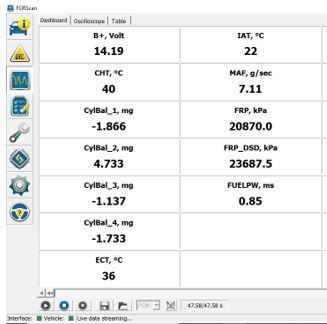A Forscan Power Balance Test can provide valuable insights into the health of your engine’s cylinders. This diagnostic test, accessible through the FORScan software and a compatible OBD-II adapter, measures the contribution of each cylinder to the overall engine power. Observing these values can help identify potential issues like misfires, fuel delivery problems, or mechanical wear. This article delves into interpreting the results of a FORScan power balance test.
Interpreting FORScan Power Balance Test Results
FORScan displays the power balance values for each cylinder as numerical data. Ideally, these numbers should be relatively close to each other, indicating that each cylinder is contributing equally. Significant deviations from the average can point to a problem with a specific cylinder.
 alt
alt
For instance, if one cylinder consistently shows a significantly higher or lower value compared to the others, it suggests that this cylinder is working harder or less efficiently. A positive value indicates that the engine control module (ECM) is adding fuel to that cylinder to maintain smooth operation, while a negative value suggests reduced fueling.
Initial Engine Behavior and Power Balance
It’s important to understand that engine behavior immediately after startup might differ from its steady-state operation. In the first few seconds, the engine may not perform power balance adjustments, leading to uneven running and fluctuating fuel rail pressure. During this period, all power balance values might read zero. As the engine warms up and the ECM initiates control, the balance values adjust, and the engine stabilizes.
Causes of Cylinder Imbalance
Several factors can contribute to cylinder imbalance detected by a FORScan power balance test. Some common causes include:
- Faulty Injectors: A malfunctioning fuel injector can disrupt fuel delivery to a specific cylinder, leading to an imbalance. This can manifest as a consistently high or low power balance value for the affected cylinder.
- Low Compression: Issues like worn piston rings or valve problems can reduce compression in a cylinder, affecting its power output. Low compression typically results in a lower power balance value for the affected cylinder.
- Spark Plug Issues: In gasoline engines, worn or fouled spark plugs can cause misfires, contributing to power imbalance.
- Vacuum Leaks: A vacuum leak can disrupt the air-fuel mixture, leading to uneven combustion and power imbalance.
- Mechanical Problems: More serious issues like damaged pistons, valves, or camshafts can also cause significant cylinder imbalances.
Investigating Abnormal Power Balance Values
If the FORScan power balance test reveals significant deviations, further investigation is necessary. This might involve:
- Visual Inspection: Check for obvious issues like loose connections, damaged wiring, or vacuum leaks.
- Fuel Pressure Test: Verify that the fuel pump and fuel rail pressure are within specifications.
- Compression Test: Measure the compression in each cylinder to identify potential mechanical issues.
- Injector Testing: Test the fuel injectors for proper operation and spray pattern.
- Spark Plug Inspection: Examine the spark plugs for wear, fouling, or damage (gasoline engines).
Conclusion: Utilizing the FORScan Power Balance Test
The FORScan power balance test is a powerful tool for diagnosing engine problems. By understanding how to interpret the results and investigate potential causes, you can identify and address issues early on, preventing more serious damage and ensuring optimal engine performance. While the test provides valuable data, it’s crucial to remember that further diagnostics might be required to pinpoint the exact cause of any imbalance detected.

